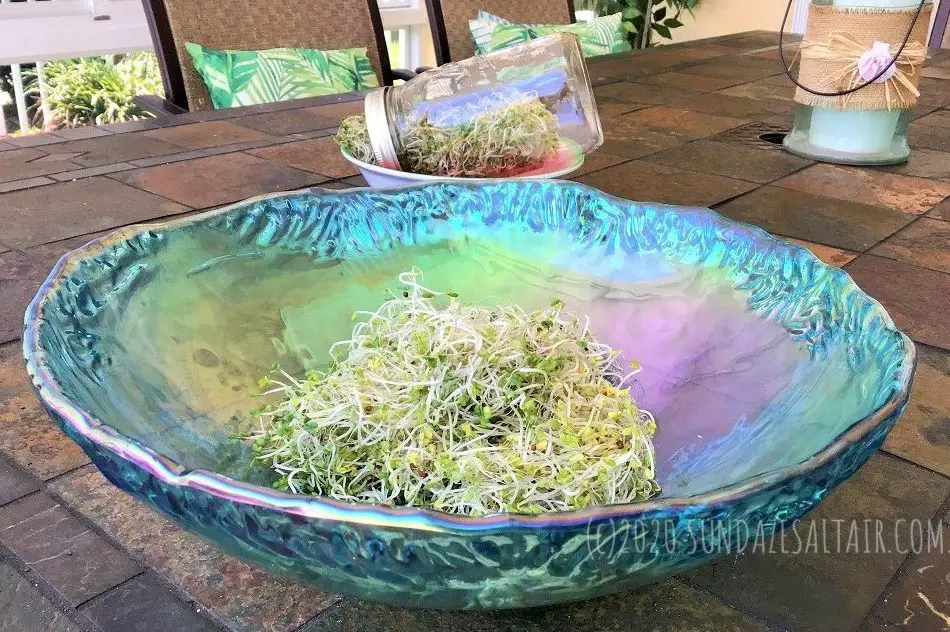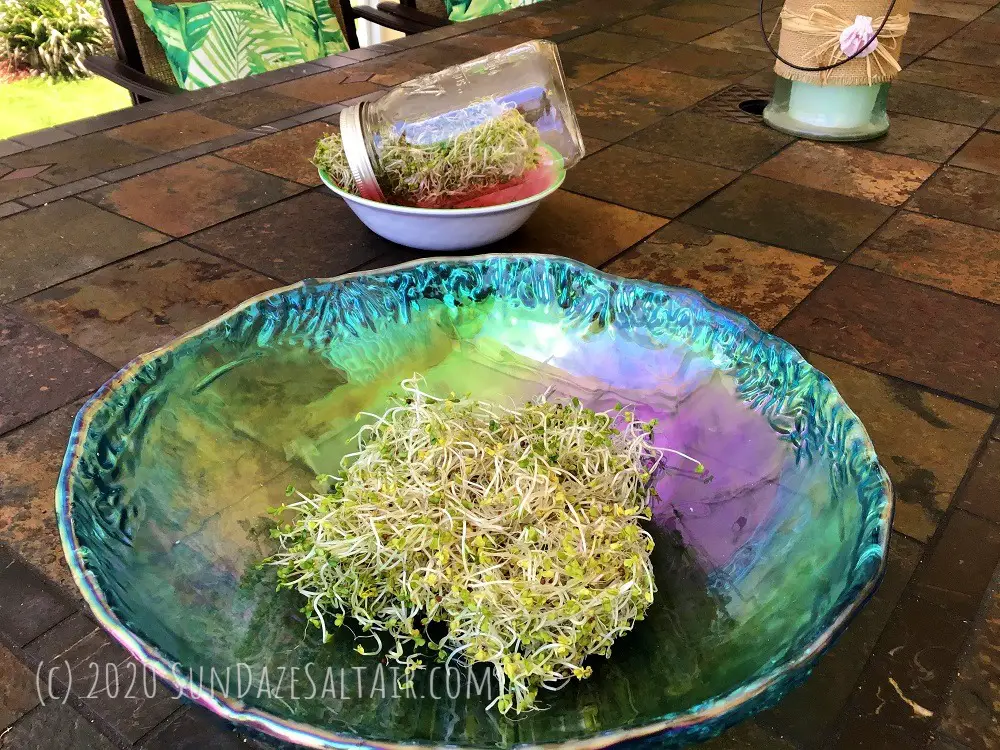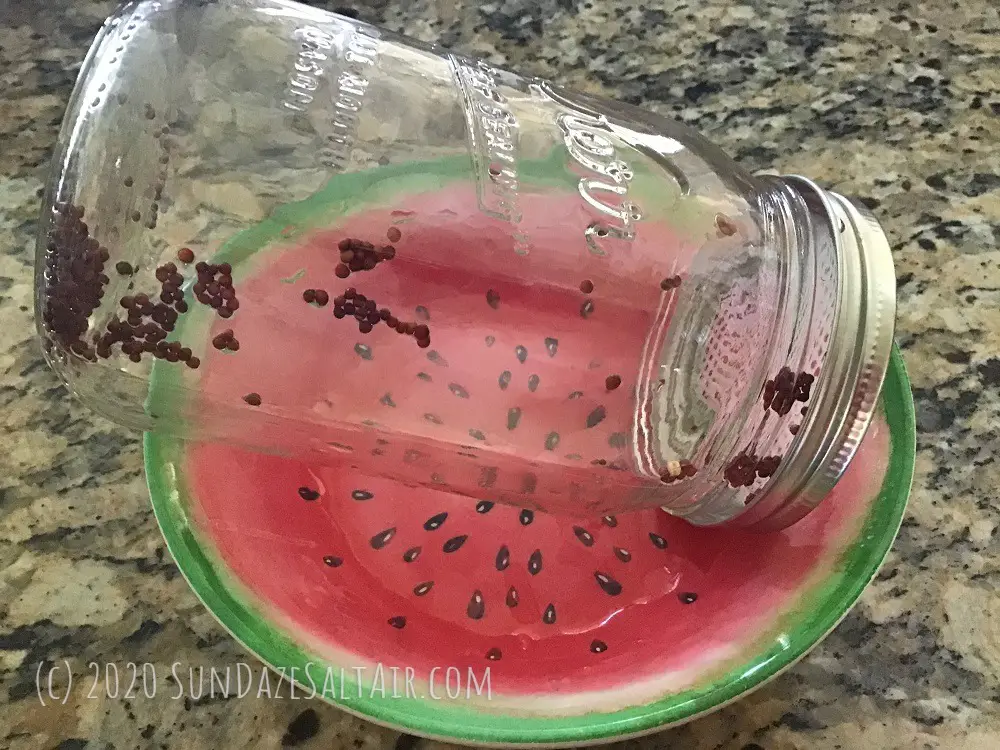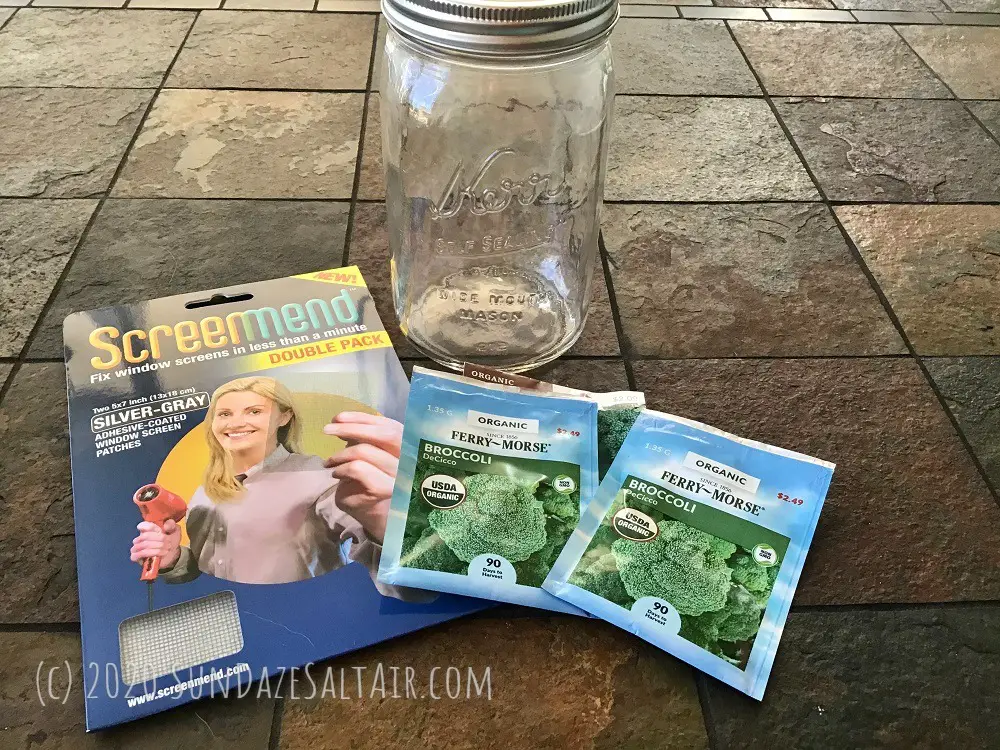
Can Sulforaphane In Broccoli Sprouts Fight Effects Of Aging, Inflammation & Progerin On Body & Skin Wrinkles? Plus How To Grow Broccoli Sprouts At Home
How Health Benefits Found In Sulforaphane In Broccoli Sprouts May Be The Secret To Slow The Effects Of Aging, Inflammation & Progerin On Your Skin & Body
The motto here is, “Inspiration to help you live your best life.” Essential to living your best life is, of course, staying your healthiest. That involves making informed choices everyday. To help you make the best, healing choices, I try to share discoveries you may not have heard of before, especially involving foods or nutrients. Now more than ever, many of us know someone who is dealing with inflammation, often in the form of some type of inflammatory condition or illness. Well, long-term inflammation is more than a painful nuisance — it may well be one of the greatest factors contributing to aging and disease. In this post, however, I highlight one of the most powerful compounds to combat inflammation — a little-known sulfur-rich phytochemical called sulforaphane.
Let’s take a closer look at the health benefits of sulforaphane, especially in broccoli sprouts, and how it may help slow aging, inflammation and disease, as well as minimize the harmful effects of a toxic protein called progerin.
Health Disclosure: This article is for informational purposes only and is not to be construed as medical advice. I encourage you to do your own research, for which I have provided links, and to always seek medical advice from your medical care provider.
**Click here to discover how anti-inflammatory essential fatty acids like those in evening primrose oil can help the body fight inflammation & repair the skin lipid barrier naturally for younger skin…

Aging & Inflammation – Can Adding Sulforaphane To Your Diet Combat Or Slow Aging By Reducing Inflammation?
It is often said that one of the biggest contributors to aging, both internally and in our external appearance, is inflammation. Not only does inflammation increase with age and certain lifestyle habits but it becomes a major source of health woes and disease as we get older. Fortunately, there are certain foods we can incorporate into our diets that are shown to help mitigate or reduce this inflammation.
One of the greatest nutrients for reducing the body’s inflammation markers is a phytochemical compound found in certain vegetables called sulforaphane. While this sulfur-based nutrient is found in varying amounts in cruciferous vegetables like brussels sprouts, cabbage, arugula and watercress, the food with the greatest concentration of sulforaphane is broccoli sprouts.
Let’s explore the myriad health benefits of broccoli sprouts and how you can grow your own broccoli sprouts at home to reduce your inflammation, improve your overall health and energy, and maybe even live longer, too.

********
Eat Broccoli Sprouts With Sulforaphane To Reduce Inflammation & Slow Down Aging At The Cellular Level
Reducing inflammation not only makes us feel and look better, it also gives us more energy, and studies show it also helps slow down our internal aging at the cellular level. Because of the huge role inflammation and oxidative stress play in the aging process, as well as in the formation of certain types of cancers, it becomes increasingly important to adapt anti-inflammatory habits and practices, including an anti-inflammatory diet with plenty of antioxidants. Let’s take a look at the specific anti-inflammatory and anti-aging benefits of sulforaphane and how this super-antioxidant can positively impact various diseases and markers associated with aging.
Can Sulforaphane Improve Brain Function & Prevent Cognitive Decline?
Recent clinical studies show sulforaphane can improve brain function in the aging brain, including memory and sharpness, and even reduce the chance of a stroke. It seems sulforaphane does this by raising levels of the potent antioxidant glutathione in both the blood and the brain. Besides boosting overall cognitive function, studies also reveal sulforaphane may promote brain chemistry balance that can help correct imbalances that are suspected in contributing to certain psychiatric disorders such as autism and schizophrenia. Read more about sulforaphane’s effect on glutathione and the brain here.
Can Sulforaphane Regenerate Nerve Tissue to Reverse Nerve & Brain Damage?
Sulforaphane has also been shown to regenerate nerve tissue to help repair brain damage. These neuroprotective effects have the potential to protect against brain and central nervous system diseases, including common debilitating central nervous system diseases such as Alzheimer’s disease, Parkinson’s disease, epilepsy, stroke, and others.
Sulforaphane appears to protect the nervous system through multiple mechanisms to help reduce the risk of disease, as well as reducing the burden of symptoms in existing conditions. You can read more here.
Can Sulforaphane Help Prevent & Fight Cancer?
Experts have long suspected that inflammation plays an important role in the development of cancer. Not surprisingly, being so highly anti-inflammatory and such a potent antioxidant, sulforaphane also demonstrates impressive anti-cancer benefits. Sulforaphane has shown to be protective of cells by blocking mutations in DNA that lead to cancer, as well as reducing the ability of cancer cells to multiply. This cancer-inhibiting ability appears to have the potential to slow tumor growth and reduce the spread of tumors. Read more about how incorporating vegetables high in sulforaphane may help reduce your cancer risk and impede the ability of cancer cells to spread.
For more on another cruciferous vegetable, watercress, and its antioxidant and anti-cancer benefits, plus some tasty recipes, check out this post here.
The Accelerated Aging Disease, Hutchinson Gilford Progeria Syndrome (HGPS) & The Accumulation Of Progerin – Can Sulforaphane In Broccoli Sprouts Fight Rapid Aging Associated With Progerin?
Studies have shown sulforaphane may also have important implications for the rapid aging that occurs in a devastating childhood genetic disorder called Hutchinson Gilford progeria syndrome, (HGPS) or “progeria” for short. This rare genetic condition causes afflicted children to have both the outward appearance of an old person, as well as internal aging we would associate with the elderly.
Do High Amounts Of Progerin Contribute To Wrinkles?
Contrary to our very notion of youth, with their line-etched faces, the progeria-afflicted children present the wrinkled facial appearance of a wise elder but the limited years and experience of a child. Like a reverse fountain of youth, aging in progeria patients is rapidly accelerated as a result of the build-up of a toxic protein called progerin. Subsequent research has revealed that children with HGPS have a faulty mechanism in their cells that allows this toxic protein, progerin, to rapidly build-up in their cells.
Because this disorder occurs at the cellular level, in addition to the dramatic, premature, visible signs of aging like wrinkles that are easily observable, these children also experience an accelerated risk and progression of age-related diseases normally only seen in the elderly. Unfortunately, the premature aging associated with this disorder often culminates in an early death around the age of 13 for these children, typically from heart disease and related symptoms of high blood pressure, stroke, or heart failure.
Progerin Levels Increase With Age Even In Healthy Individuals
While an apparent genetic mutation in the LMNA gene is responsible for this progerin accumulation in HGPS patients that leads to early cell death, according to researchers, interestingly, this toxic protein is also found in smaller amounts in individuals with normally aging cells. Aging and a corresponding decline in the ability to breakdown this abnormal protein is, not surprisingly, associated with many age-related pathologies including Alzheimer’s disease, Parkinson’s disease, heart disease, cataracts and vascular disease.
What Can Progerin’s Effect On Accelerating Aging In Progeria Tell Us About The Aging Of Normal, Healthy Skin & Body Cells?
In looking at the protein profiles in HGPS skin cells and normal skin cells, scientists discovered that while progerin is present in small amounts in normal cells, in HGPS cells, the defective protein is present at a rate of ten to twenty times that of healthy cells. Normally healthy cellular machinery breaks down progerin, and while the degradation or breakdown process becomes less effective in all of us as we age, it is impaired from the start in patients with progeria.
In the quest to slow down the rapid cellular aging that occurs in progeria patients, scientists focused on blocking the production of progerin using chemical inhibitors. In the process, Dr. Karima Djabali and her team at Columbia University, observed much lower proteasome activity in HGPS cells than in normal cells. These findings confirmed their hypothesis that while HGPS and normal cells both produce the rogue protein, a faulty “waste removal” mechanism in HGPS cells is responsible for the progerin build-up that causes the early cellular death so characteristic of progeria.
While aging is a complex process controlled by a variety of genetic and lifestyle factors, it stands to reason that anything found to “speed” up this progerin removal process would benefit both patients with progeria as well as healthy individuals experiencing typical aging.
Can Sulforaphane In Broccoli Sprouts Fight Aging & Progerin Build-Up? Research Shows Sulforaphane May Prevent Or Slow Progerin Accumulation In Cells, Inhibit Oxidation & Reduce Cellular DNA Damage
In seeking compounds that would enhance proteasome activity and help remove progerin faster, the research team discovered that the chemical compound in broccoli sprouts, sulforaphane, is one such powerful phytochemical. Sulforaphane exhibits the ability to inhibit progerin production by helping repair the faulty mechanism that causes progerin build-up in cells in the first place.
The research findings indicate that treatment with sulforaphane more efficiently repairs the DNA damage in HGPS cells, thereby reducing DNA damage present in such cells, and ultimately improving cell growth. Sulforaphane’s powerful antioxidant capabilities inhibit the oxidation of molecules, further reducing cellular damage. As a result of this research, sulforaphane is a promising therapeutic for children with HGPS, as well as an overall potent antioxidant with numerous anti-inflammatory and anti-aging health benefits. Read more here.
If the antioxidant sulforaphane, found in such high concentration in broccoli sprouts, can enhance progerin clearance in the cells of children with HGPS, one may extrapolate sulforaphane would have a similarly promising effect on the rogue protein’s aging effects on the skin and body of normally aging individuals. You can read more about this exciting research here.

********
How To Grow & Consume Broccoli Sprouts To Get All The Benefits Of Sulforaphane
No Garden Required — Just Ensure Dry & Well-Ventilated Growing Conditions To Avoid Mold
Now that we understand the numerous health benefits of sulforaphane in broccoli sprouts, let’s grow some! Broccoli sprouts are easy and quick to grow no matter where you live — or how much or little space you have. You don’t need an outdoor garden and you don’t even need a lot of time, as you can have your sprouts ready to eat in under a week.
Just make sure to grow your broccoli sprouts in dry, non-humid conditions with plenty of ventilation. By around day three, place your jars near a window-sill where they can receive some indirect natural light. If you follow these instructions, and make sure to stand jars so the sprouts can drain properly, it should help you avoid mold issues common when growing sprouts.
Some Sulfur Odor From Sulforaphane Should Be Expected
One other thing to keep in mind when growing something that produces sulforaphane, is that a distinct sulfur-like odor may become noticeable. This is usually just an indicator of the potency of the sulforaphane and no cause for alarm. Daily rinsing and draining, plus growing your sprouts in a well-ventilated, and later, well-lit space should keep the smell from becoming overpowering.
Save Money With An Inexpensive & Easy Broccoli Sprout “Container” Garden
Now, between many of us spending plenty of time at home plus the rising cost of food, there is no better time to start a kitchen or patio garden. What better first “crop” to start with than super nutritious broccoli sprouts… There really is no good excuse not to grow these at home! But first, a few notes on how to eat your sprouts to get the most benefits out of your broccoli sprout garden.
Chew Your Broccoli Sprouts For Maximum Benefits
One important thing to note about sulforaphane in broccoli sprouts is that, in order to activate the phytochemical compound, you need to be sure to chew your broccoli sprouts to physically break them down. The physical breakdown helps release the potent sulforaphane so make sure you don’t swallow your broccoli sprouts, or you will miss out on all the health benefits.
Freeze Your Broccoli Sprouts For Best Results But Do Not Cook Them
The second important thing to note is that, unlike most vegetables, freezing broccoli sprouts can nearly double sulforaphane’s potency and activation, however, thawing them can cause it to leach out. Therefore, when you freeze and eat your broccoli sprouts, you will actually need to eat less of them to get the same effect as you would eating unfrozen sprouts.
Therefore, for best results, freeze your broccoli sprouts, and make sure to chew them thoroughly.
Eat Your Broccoli Sprouts Raw For Maximum Results
While freezing enhances the nutrient content, cooking does the opposite, destroying sulforaphane. That’s not to say to avoid cooked cruciferous vegetables as they are still healthy in a multitude of ways, but for maximum sulforaphane benefits, eat your broccoli sprouts raw; especially if they are home-grown and you know they are safe from being contaminated by harmful bacteria.
Are Broccoli Sprouts The Same As Broccoli?
Simply put, broccoli sprouts are the “baby” version of broccoli but happen to have much more concentrated amounts of nutrients, making them much more nutritious than their mature counterparts. You would have to eat about twenty times more broccoli to get the same health benefits you could get from a similar amount of broccoli sprouts.
Are There Possible Side Effects To Consuming Broccoli Sprouts?
Sulforaphane is considered safe when consumed in plant form, and even in supplement form it is considered to have few side effects, although studies are limited and not long-term. The main observed side-effects, as with many cruciferous vegetables, are digestive issues, such as gas. You can read more here.
The primary danger with raw sprouts is usually with store-bought sprouts that may be contaminated by harmful bacteria. Avoid eating sprouts from an unknown origin, rinse any sprouts thoroughly, and your best bet is to stick with home-grown sprouts that you know are safe from bacterial contamination.
Serving Suggestions
Mix your broccoli sprouts into yogurt, smoothies, or garnish your dinners, salads, and soups. Plus, you can eat the sprouts just like a snack.
********

How To Easily Make Your Own Broccoli Sprout Garden Anywhere
Supplies You Will Need:
Affiliate Disclosure: This post contains some affiliate links for which a small commission may be earned if you decide to make a purchase through a link, at no extra cost to you.
16 oz. or 32 oz. Canning jars, preferably wide-mouth, such as Mason jars — I often use three at a time so I always have enough sprouts around;
Sprouting lids — For an easy, inexpensive, DIY option, try using a “screen repair” product you can find in your local hardware store or here. The mesh holes are so fine and the material is so thin, you don’t even have to cut out a circle as the lid will still fit right over it. Plus, you now have a screen section handy in case you need to repair any holes in your window screens. FYI, I have tried using plastic mesh that I found in the crochet department of a craft store, but the holes were too large so you risk losing seeds when rinsing them.
A tray or bowl — in which you can stand your tilted jar to catch the water that drains after rinsing.
Organic broccoli seeds — I use two or three tablespoons of seeds per jar depending on the jar size.
Instructions To Grow Your Own Broccoli Sprouts At Home
- Begin with a thoroughly clean Mason jar. Add between two to three tablespoons of broccoli seeds, depending on whether you use a 16 ounce or 32 ounce jar.
- Add one cup of water to the jar to completely cover all seeds. You can use pure, distilled water but any water will do. Add 2 tablespoons of apple cider vinegar to prevent any bacteria growth.
- Attach the sprouting lid to your jar. If you choose to use the DIY “screen repair” screen mesh, because the material is so thin, you don’t have to cut out a circle as the lid will still fit right over it tightly. If you want to trim your mesh, just place the jar lid on the mesh and trace around it with a washable marker. Cut around the traced circle and you have a perfect mesh sprouting circle for inside the rings of your jars.
- Let the jar with the water and vinegar-submerged broccoli seeds stand for at least six hours, or overnight, in a cool, dry place.
- Once at least six hours is up, drain the jar of all water through the mesh lids by tipping the jar.
- Thoroughly rinse your seeds with fresh water while still in the jar, swirling them around so they are well-rinsed. Then tip them so the water drains.
- Allow the jar to continue to be tipped in a tray or bowl so residual water drains into the tray throughout the day, for about twelve hours.
- Before you go to bed, repeat the process of rinsing the seeds by adding water and swirling it around. Immediately tip the jar to drain the water into the sink. Again, stand the water upside down at a 45 degree angle into the tray or bowl for drainage, leaving it like that overnight. By day three, you can place the jar where it receives some indirect sunlight.
- Repeat this process of rinsing and draining your seeds twice a day, in the morning and again before bed, for up to five or six days. Drainage is very important so your seeds don’t get moldy.
- By the fifth or sixth day, your broccoli seeds should have fully sprouted, so you can remove them from the jar, rinse, and start eating! A 32 ounce jar can likely serve two people. Like any perishable, broccoli sprouts will only stay fresh for a few days if stored in the fridge.

Grow Broccoli Sprouts At Home For All The Health Benefits Of Sulfurophane To Combat The Effects Of Aging, Inflammation & Progerin On Your Skin & Body
With all the advances in genetics, health and medicine, scientists have long studied various ways to slow down the aging process. While the pursuit of youth, beauty and vitality is as old as mankind itself, thanks to the eternal hope and optimism of the human spirit, the pursuit continues to live on. Nowhere, perhaps, is this more a matter of “life or death” than the research efforts undertaken to understand and potentially slow down the abnormally rapid cellular aging process that occurs in children with Hutchinson Gilford progeria syndrome.
Thanks to the work of researchers, we now know that the antioxidant/phytonutrient sulforaphane, found in cruciferous vegetables, and in broccoli sprouts in great concentration, increases proteasome activity, lowers progerin levels, and improves cellular health. Treatment with sulforaphane also leads to more efficient DNA repair in HGPS cells, consequently lowering the levels of DNA damage in these cells. Whether your goal is better health, longevity, quality of life or simply feeling your best, sulforaphane certainly has health and beauty benefits to make them well worth considering incorporating into your diet and lifestyle.
********
Have your tried growing your own broccoli sprouts at home? Do you incorporate broccoli sprouts in your diet?
Share any health benefits you have felt or observed by consuming broccoli sprouts in the comments.


You May Also Like

Jane Iredale Enlighten Plus Under-Eye Concealer Review & First Impression
March 24, 2021
MagicBax Earring Lifter Review – Prevent Sagging Earrings Easily & Inexpensively Without Plastic Surgery
September 10, 2020